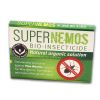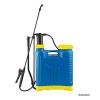How to Control Against Leather Jackets
Leather Jackets are a pest on both lawns and vegetables. These grubs are the larvae of the Crane Fly. They are a major problem as there is few known chemical control methods and this means that the pest must be controlled through good practice or biological means.

The life cycle of the crane fly begins with the laying of eggs in the soil. This happens between the months of July & October with the busiest month being September. So this is a long period where the female crane fly needs to be kept off and away from your garden soil to prevent egg laying.
The eggs hatch to larvae as it is at this stage that they are most destructive. They overwinter in the soil and the following Spring the larvae become active again and begin to feed on the roots of grass. Leather jackets are most common in lawns but they can be found in greenhouse soil and vegetable gardens. Potatoes too can be badly affected as the larvae burrow into the tubers. They can do significant damage to plants as they feed on the plants root system, while at night they also come up above the soil to feed on plant stems.
How to Recognise Leather Jackets
The adult fly, known as the crane fly is quite similar to the daddy long legs. The Crane flies have small bodies, one pair of wings and 6 legs approx. 2inch in length.
The larvae leather jackets can reach approx. 4cm in length. They are grey or brown in colour with a waxy coat and grub like. Mostly you will find them just under the soil surface, but at night they are known to venture above ground.
They will kill grass causing patches of yellow or brown grass across the lawn. If you notice a lot of birds pecking at your lawn they may be feeding on the larvae, so this is another sign of infestation.
If you believe you have leather jackets in your lawn you should dig up the area where the problem is occurring. The pests should be visible just below the soil surface.
How to Control Against Leather Jackets
Chemical options
There are some chemicals that will control against leather jackets namely Imidacloprid & Chlorpyrifos. These should be applied to problem areas around August.
Biological options
Biological controls include: Steinernema feltiae. This beneficial nematode will live in the soil and feed on the leather jacket larvae controlling them and reducing their numbers
SuperNemos offers effective & safe biological control against Leather Jackets
Other controls include
Good practice: stay vigilant and on top of the problem. Inspect lawns and soil to determine level of problem.
Polythene: Place a sheet of polythene over your lawns affected area. This will bring the larvae to the soil surface and will allow you to remove them by hand – if you can muster up the courage!








